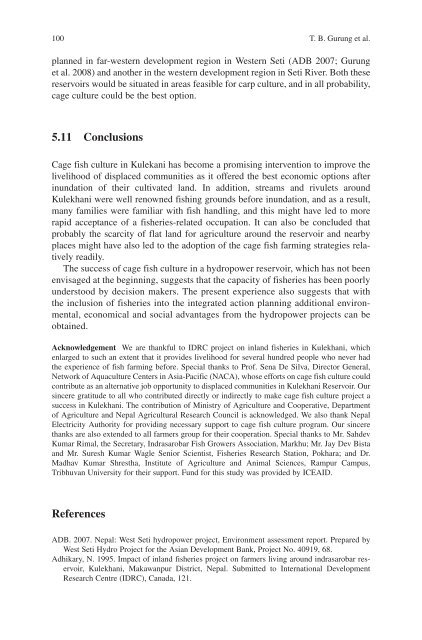Success Stories In Asian Aquaculture - Library - Network of ...
Success Stories In Asian Aquaculture - Library - Network of ...
Success Stories In Asian Aquaculture - Library - Network of ...
- No tags were found...
You also want an ePaper? Increase the reach of your titles
YUMPU automatically turns print PDFs into web optimized ePapers that Google loves.
100 T. B. Gurung et al.planned in far-western development region in Western Seti (ADB 2007 ; Gurunget al. 2008) and another in the western development region in Seti River. Both thesereservoirs would be situated in areas feasible for carp culture, and in all probability,cage culture could be the best option.5.11 ConclusionsCage fish culture in Kulekani has become a promising intervention to improve thelivelihood <strong>of</strong> displaced communities as it <strong>of</strong>fered the best economic options afterinundation <strong>of</strong> their cultivated land. <strong>In</strong> addition, streams and rivulets aroundKulekhani were well renowned fishing grounds before inundation, and as a result,many families were familiar with fish handling, and this might have led to morerapid acceptance <strong>of</strong> a fisheries-related occupation. It can also be concluded thatprobably the scarcity <strong>of</strong> flat land for agriculture around the reservoir and nearbyplaces might have also led to the adoption <strong>of</strong> the cage fish farming strategies relativelyreadily.The success <strong>of</strong> cage fish culture in a hydropower reservoir, which has not beenenvisaged at the beginning, suggests that the capacity <strong>of</strong> fisheries has been poorlyunderstood by decision makers. The present experience also suggests that withthe inclusion <strong>of</strong> fisheries into the integrated action planning additional environmental,economical and social advantages from the hydropower projects can beobtained.Acknowledgement We are thankful to IDRC project on inland fisheries in Kulekhani, whichenlarged to such an extent that it provides livelihood for several hundred people who never hadthe experience <strong>of</strong> fish farming before. Special thanks to Pr<strong>of</strong>. Sena De Silva, Director General,<strong>Network</strong> <strong>of</strong> <strong>Aquaculture</strong> Centers in Asia-Pacific (NACA), whose efforts on cage fish culture couldcontribute as an alternative job opportunity to displaced communities in Kulekhani Reservoir. Oursincere gratitude to all who contributed directly or indirectly to make cage fish culture project asuccess in Kulekhani. The contribution <strong>of</strong> Ministry <strong>of</strong> Agriculture and Cooperative, Department<strong>of</strong> Agriculture and Nepal Agricultural Research Council is acknowledged. We also thank NepalElectricity Authority for providing necessary support to cage fish culture program. Our sincerethanks are also extended to all farmers group for their cooperation. Special thanks to Mr. SahdevKumar Rimal, the Secretary, <strong>In</strong>drasarobar Fish Growers Association, Markhu; Mr. Jay Dev Bistaand Mr. Suresh Kumar Wagle Senior Scientist, Fisheries Research Station, Pokhara; and Dr.Madhav Kumar Shrestha, <strong>In</strong>stitute <strong>of</strong> Agriculture and Animal Sciences, Rampur Campus,Tribhuvan University for their support. Fund for this study was provided by ICEAID.ReferencesADB. 2007. Nepal: West Seti hydropower project, Environment assessment report. Prepared byWest Seti Hydro Project for the <strong>Asian</strong> Development Bank, Project No. 40919, 68.Adhikary, N. 1995. Impact <strong>of</strong> inland fisheries project on farmers living around indrasarobar reservoir,Kulekhani, Makawanpur District, Nepal. Submitted to <strong>In</strong>ternational DevelopmentResearch Centre (IDRC), Canada, 121.
















